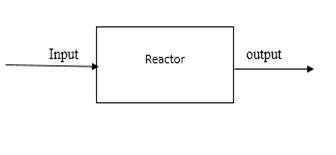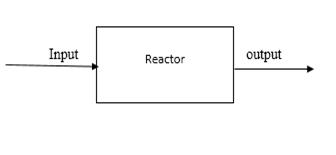
(a)
Interpretation:
Flow chart for the process should be prepared. Also, the degree of freedom for the process should be determined.
Concept introduction:
Flow chart for the process is determined on the values of input and output that is the amount of feed entered in the reactor and product formed also helps to predict the amount accumulated during formation of product.
This gives the relation,which is defined as,
Input-output = Accumulation.
The flow sheet for the process is shown below,

For a single reaction system, the final moles of each of the components present, can be estimated by the equation:
Here,
Mole fraction
Here,
(b)
Interpretation:
The set of equation identifying the process for the given data should be determined.
Concept introduction:
Mole fraction
Here,
Volumetric flow rate is defined as the product of area for the flow and cross sectional velocity having unit of cubic feet/second.
(c)
Interpretation:
The values of all equations calculated in part (b) should be calculated.
Concept introduction:
Mole fraction
Here,
Volumetric flow rate is defined as the product of area for the flow and cross sectional velocity having unit of cubic feet/second.
(d)
Interpretation:
The value of total heat requirements in kW for methane and oxygen preheater should be determined. Also, the value of temperature attained in convertor should be calculated.
Concept introduction:
The amount of heat transferred is
The enthalpies of reactants and products depends on the heat capacity and temperature.
(f)
Interpretation:
The additional steps can be included in the absorber and stripper off gas should be explained.
Concept introduction:
Flow chart for the process is determined on the values of input and output that is the amount of feed entered in the reactor and product is formed also helps to predict the amount accumulated during formation of product.
This gives the relation, which is defined as
Input-output = Accumulation.
The flow sheet for the process is shown below,

Trending nowThis is a popular solution!

Chapter 9 Solutions
EBK ELEMENTARY PRINCIPLES OF CHEMICAL P
- (b) Heat is generated by the core of a nuclear reactor, this heat is removed by pumping cooling water through the core at a rate of 45 x 106 kg/h to generate steam. Cooling water, initially at 30 °C is continuously pumped through the reactor so that the outlet temperature is 748 °C and the core temperature remains constant. Calculate the rate of heat generated by the core of a nuclear reactor (in joules per second). (The specific heat capacity of ice 2100 Jkg 'K1; water = 4190 Jkg K; steam 2010 Jkg K. The latent heat of fusion of water is 334 kJ kg: latent heat of vaporisation of water 2264 kJ kg)arrow_forwardOxy-acetylene torches can be used to cut or weld metal. Oxygen and acetylene are fed from separate compressed gas cylinders through pressure regulators to the torch where they are mixed and combusted. To estimate the amount of metal that can be cut or welded per unit volume of gas, the composition of the gases produced by combustion and heat produced by the combustion reaction must be determined. For this problem: a. Define a closed system that can be used to calculate the heat produced b. Define an open system that can be used to calculate the heat produced c. List at least two intensive variables that are important in calculation d. List at least two extensive variables that are important in the calculationarrow_forward3. Two moles of an equimolar mixture of CO and H₂O (i.e., one mole of carbon monoxide and one mole of water vapor) is placed in an experimental reactor in which the water- gas shift reaction: CO(g) + H₂O(g) → CO₂(g) + H₂(g) occurs at 2 Atm and at a temperature at which 4G rxn= -0.6932RT. Determine the equilibrium composition (mole fractions) in the reactor.arrow_forward
- A vehicle airbag system works by using a series of chemical reactions. When sensors in the system detect a collision, a heat source instantly causes the decomposition of sodium azide at 300oC. This first reaction produces sodium metal and nitrogen gas. The formation of the nitrogen gas inflates the airbag, but unfortunately, the other product, sodium metal, is extremely dangerous and highly reactive. The sodium metal must undergo an immediate secondary reaction to transform into a safer substance. That’s where potassium nitrate gets involved. In the secondary reaction, sodium metal reacts with the potassium nitrate to form potassium oxide, sodium oxide, and additional nitrogen gas. This secondary generation of nitrogen gas also fills the airbag. Excess gas from the secondary reaction gets vented from e airbag. Finally, in the third and fourth reactions, the sodium oxide and potassium oxide react with silicon dioxide separately to product harmless and stable silicate glasses sodium…arrow_forwardThe amount of oil and grease from the rivers beside mining sites are quantified by solvent-solvent extraction. The dissolved oil and grease from the organic solvent will then be dried and weighed. What type of gravimetry is described by the statement? O precipitation gravimetry O physical gravimetry thermogravimetry electrogravimetryarrow_forwardWhich one of the following processes does NOT involve the transfer of energy via work when the reaction is carried out at constant pressure in a vessel open to the atmosphere? - Reaction of nitrogen monoxide gas and oxygen gas to form gaseous nitrogen dioxide. - Decomposition of solid calcium carbonate to solid calcium oxide and carbon dioxide gas. - Conversion of gaseous nitrogen dioxide to gaseous dinitrogen tetroxide. - Reaction of solid copper(II) sulfate and water vapor to form solid copper(II) sulfate pentahydrate. - Combustion of solid sucrose (C12H22O11) in oxygen gas to form carbon dioxide gas and liquid water.arrow_forward
- TVA’s Kingston Fossil Plant near Cedarville, Tennessee, burns about 14,000 tons of coal a day. A typical rail car is 53 ft long from coupling to coupling, weighs 30 tons empty and can carry 100 tons of coal. How many minutes would you have to wait at a crossing for this train to pass, each day, if it was pulled by four locomotives, each 70 ft long and moving at 10 miles per hour through town? Such delays cause decreased ability to provide effective emergency response times and interference with commuters and local freight delivery affecting the local economy.arrow_forwardThis was a lab I performed where we mix aqueous 25ml HCl and 25ml NaOH and use a program called microlab to determine the cooling rate after the initial heating. We used a coffee cup calorimeter that had a stirring bar. At first, NaOH solution is by itself in the coffee cup calorimeter. It’s temperature was 23.02 C. I waited for 70 seconds and then added the 25ml of HCl to it. The temperature rose to 29.59 C, then began to cool down immediately. The cooling rate was y=0.0089x+26.1273 according to the program. The final weight of the solution was 47.147g. The moles of NaOH was 0.919M and HCl was 1.033M. The questions: calculate the theoretical value for change in delta Hrxn.arrow_forwardIn the leachate pond, carbon, sulphur and nitrogen mostly exist as reducing compounds due to the pond's anaerobic conditions. The reduced species are responsible for the odours at the leachate pond and the stream. The concentrations of these reduced species can be lowered by exposing the water of the pond to a steady stream of oxygen similar to the system adopted in fish tanks. For example, ammonium found in the reduced water can be converted to nitrates and acid in the presence of oxygen according to the equation below: NH4+ (aq) + 2O2 (aq) + H2O (l) = NO3– (aq) + 2H3O+ (aq) + heat (a) Write the equilibrium expression of the equation above. (b) State how the following change will shift the above equilibrium: Cooling of the pond water at nightfall addition of an inorganic catalyst (c) You are concerned about the acid produced from the reaction. The pH of the leachate pond shifted from 6.1 to 4.8 as a result of the treatment. Calculate the [H3O+] at both…arrow_forward
- A geochemist in the field takes a 9.0 mL sample of water from a rock pool lined with crystals of a certain mineral compound X. He notes the temperature of the pool, 15. C, and caps the sample carefully. Back in the lab, the geochemist first dilutes the sample with distilled water to 400. mL.. Then he filters and evaporates all the water under vacuum. Crystals of X are left behind. The researcher washes, dries and weighs the crystals. They weigh 0.045 g. Using only the information above, can you calculate the solubility of Xin water at 15.° C7 If you said yes, calculate it. Be sure your answer has a unit symbol and 2 significant digits. yes O no 0 0.9 H ロ・ロ X 0 Garrow_forwardA chemical engineer must calculate the maximum safe operating temperature of a high pressure gas reaction vessel, The vessel is a stainless-steel cylinder that measures 17.0 cm wide and 20.4 cm high. The maximum safe pressure inside the vessel has been measured to be 6.10 MPA For a certain reaction the vessel may contain up to 0.755 kg of sulfur hexafluoride gas. Calculate the maximum safe operating temperature the engineer should recommend for this reaction, Write your answer in degrees Celsius. Be sure your answer has the correct number of significant digitsarrow_forwardGiven the data in the table below, AHrxn for the reaction Ca(OH); + 2H;AsO4 → Ca(H;AsO4)2 + 2H;O is _ kJ. [A] -4219 (B] -130.4 [C] -4519 [D] -76.4 AH, (kJ/mol) -986.6|| Substance Ca(ОН), HASO, Ca(H;AsOa)2 -900.4 -2346.0 H;0 -285.9 O A В C Darrow_forward
 Principles of Modern ChemistryChemistryISBN:9781305079113Author:David W. Oxtoby, H. Pat Gillis, Laurie J. ButlerPublisher:Cengage Learning
Principles of Modern ChemistryChemistryISBN:9781305079113Author:David W. Oxtoby, H. Pat Gillis, Laurie J. ButlerPublisher:Cengage Learning
